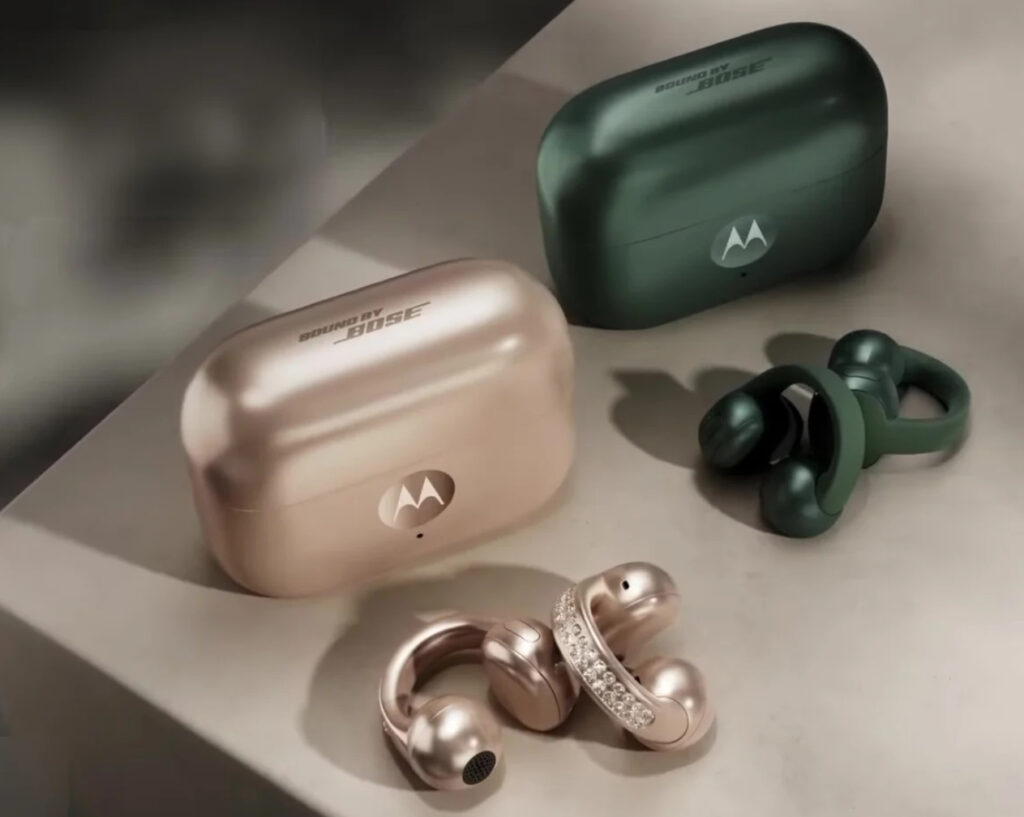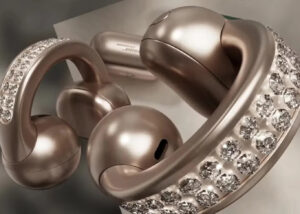

The Silent Revolution in Personal Audio
Once hidden necessities, wireless earbuds have undergone a metamorphosis—emerging from the shadows of utility to claim their place as the defining accessory of the 2020s. No longer content to nestle discreetly in ears, they now perch like miniature sculptures atop cartilage, their designs scrutinized as closely as the watches and rings they’ve begun to eclipse.
Motorola’s Moto Buds Loop, unveiled in April 2025, represents the apex of this shift. With their open-ear design, Swarovski crystal embellishments, and collaboration with Milan-based jewelry designer Marco Dal Maso, they signal a future where earbuds are judged not just by their acoustic fidelity, but by their ability to complement a runway look.
This is the story of how audio became wearable art.
From Function to Fashion: The Evolution of the Earbud
A decade ago, wireless earbuds were the stuff of gym rats and subway commuters—practical, utilitarian, and largely forgettable. They were bought for battery life, connection stability, and sound quality. They were accessories in the most literal sense: supplementary, invisible, and entirely subordinate to the smartphone.
But then something shifted.
First came the rise of lifestyle branding in tech. Apple’s AirPods weren’t just good earbuds—they were cultural capital. A symbol of minimalism, productivity, and affluence. They inspired memes, critiques, and, eventually, counter-designs. Other tech brands took note, and a design arms race quietly began.
In parallel, the fashion world started looking sideways at tech. If you can wear a smart ring or a fitness tracker, why not earbuds that double as earrings? The question wasn’t just aesthetic. It was economic. Consumers were already willing to spend $200+ on audio gear. What if that same gear could stand in for a piece of luxury jewelry?
Enter the Moto Buds Loop: Where Audio Meets Adornment
Motorola’s Moto Buds Loop doesn’t just flirt with fashion—it commits.
At first glance, they resemble high-end ear cuffs or modular jewelry rather than tech. A curved, open-ear frame wraps around the outer ear, leaving the canal unobstructed. The sound is directed inward via a precise audio beamforming system—no tips to shove in, no pressure, no discomfort. But it’s the look that turns heads.
The buds are adorned with Swarovski crystals—strategically placed to catch light and attention. The collaboration with Marco Dal Maso brings a sculptural, almost architectural sensibility to the design. The limited-edition version, available in brushed gold, obsidian black, and pearl white, wouldn’t look out of place in a vitrine at Milan Design Week.
Inside, the Moto Buds Loop packs competitive specs: adaptive noise isolation (via counter-wave audio projection), multi-point Bluetooth 5.4 connectivity, spatial audio optimization, and up to 12 hours of continuous playback with the companion charging locket.
But Motorola’s play isn’t just about tech. It’s about status.
Tech’s Infiltration of Luxury—and Vice Versa
The Moto Buds Loop exists in a context where the line between consumer tech and luxury fashion has never been thinner.
Brands like Louis Vuitton have already dabbled in this hybrid space with their Horizon earbuds. Likewise, Gucci partnered with Fnatic to drop a luxury gaming headset. Even Bang & Olufsen, long known for design-led audio, now positions its products closer to fashion than tech.
Why? Because wearables have become more intimate. Phones live in our pockets. Watches and earbuds live on us. That makes them a new canvas for self-expression—and an opportunity for brand alignment.
The Moto Buds Loop embraces this with boldness. This isn’t “tech that looks nice.” It’s fashion that happens to deliver premium audio. It’s no accident that Motorola’s reveal wasn’t at CES or MWC, but during Milan Fashion Week.
Design as Differentiator: Breaking Out of the Tech Box
For years, the design language of earbuds was utilitarian at best—smooth plastic, white or black, maybe a matte finish if you were lucky. The Moto Buds Loop tears that playbook up.
The open-ear loop structure not only makes a visual statement, but it also avoids the occlusion effect that traditional in-ear buds create—no muffled internal sounds or ear fatigue after long use. Instead of hiding in the ear canal, the Loop frames the ear like a high-end piercing.
Dal Maso’s touch is subtle but essential. These aren’t over-designed or gaudy. They’re refined. Intentional. They borrow from modern jewelry cues: balance, proportion, tactile texture. Each pair is meant to be seen, worn, and styled.
A New Kind of Consumer: The Techno-Aesthetic Buyer
The target market isn’t just audiophiles. It’s style-conscious early adopters, luxury consumers looking for functional fashion, and younger buyers who no longer separate tech from self-expression.
These buyers aren’t reading spec sheets. They’re browsing lookbooks. They don’t want earbuds that blend in—they want them to stand out, to say something about taste, status, and personal style.
Motorola’s move taps into that desire. It’s not a mass-market play; it’s a cultural positioning move. It’s for the kind of person who pairs their watch face to their outfit, who switches cases with the season, who sees accessories not as afterthoughts but as part of the daily uniform.
Audio as Identity: The Broader Shift in Tech Culture
What we listen to says something about who we are. So does how we listen. Just as vinyl heads show off their turntables and headphone collectors compare DACs, the average consumer is starting to care not just about their audio quality, but their audio presentation.
This trend extends beyond earbuds—into wearable speakers, sound jewelry, and even spatial audio environments that adjust based on your mood and fashion. Brands are watching. And responding.
Motorola isn’t just selling earbuds. It’s joining a movement toward experiential, expressive audio tech. It’s the reason the Moto Buds Loop packaging includes a velvet-lined case, a care card more akin to a jewelry tag, and a mini catalog of suggested style pairings.
Critics and Cynics: Is This Just Designer Hype?
Not everyone’s sold. Some critics argue that prioritizing form over function could hurt performance. Others roll their eyes at the “fashionification” of yet another product category. There’s also skepticism around price—will enough people really drop $399 on a pair of fashion-forward earbuds?
But those critiques miss the point. This isn’t about mass adoption. It’s about pushing boundaries, setting new expectations, and creating space for more expressive, varied forms of personal tech.
Just as luxury watches exist alongside $50 Casios, there’s room for both practical earbuds and high-end audio jewelry. The Moto Buds Loop isn’t trying to replace AirPods—it’s carving out its own niche entirely.
What Comes Next: The Future of Audio Accessories
The Moto Buds Loop might just be the start.
We’re already seeing concept designs for earbuds with interchangeable charms, modular hardware, and even AI-based adaptive style engines that tweak the audio and lighting to match your outfit or vibe.
Expect more partnerships between audio brands and fashion houses. More runway launches. More limited drops. Earbuds will stop being just an accessory—and start being the centerpiece.
Motorola’s bold step into this space is a signal: audio is no longer just about what you hear. It’s about what you wear, show, and signify.
Impression
From humble audio tool to high-fashion statement, the journey of the earbud reflects the broader evolution of personal tech—from invisible utility to visible identity.
The Moto Buds Loop is more than a product. It’s a flag planted in a new territory—where design, sound, and status converge. Where your earbuds say as much about you as your shoes or your scent.
In the 2020s, you don’t just wear your heart on your sleeve. You wear your playlist on your ear—and you make damn sure it looks good doing it.
No comments yet.








